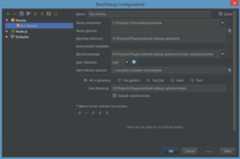- Notifications
You must be signed in to change notification settings - Fork6
stefanwalther/es6-debug-webstorm
Folders and files
| Name | Name | Last commit message | Last commit date | |
|---|---|---|---|---|
Repository files navigation
Just a short reminder for myself how to get debugging to work in WebStorm with ES6.If it helps also you, then great! ;-)
Folder structure being used:
root|-- src |-- index.js |-- sample.js.babelrcgulpfile.babel.jspackage.jsonContent of.babelrc:
{"presets":["es2015"]}
The setup described below uses gulp 3.x to transpile ES6 files to ES5, including source-maps, which can then be used in WebStorm to debug ES6.
Note:As soon as gulp 4.0 is out, some changes are necessary, gulp 4.0 introduces some breaking changes.
Install the required modules as devDependencies:
- babel-core
- babel-preset-es2015
- gulp
- gulp-babel
- gulp-sourcemaps
$ npm install babel-core babel-preset-es2015 gulp gulp-babel gulp-sourcemaps --save-dev
Note:babel-core andgulp can and probably should be installed globally.
- Instead of naming your gulp file
gulpfile.jsrename it togulpfile.babel.js - Use the following gulp-script:
importgulpfrom"gulp";importsourceMapsfrom"gulp-sourcemaps";importbabelfrom"gulp-babel";importpathfrom"path";constpaths={es6:['./src/**/*.js'],es5:'./dist',// Must be absolute or relative to source mapsourceRoot:path.join(__dirname,'src')};gulp.task('babel',()=>{returngulp.src(paths.es6).pipe(sourceMaps.init()).pipe(babel({presets:['es2015']})).pipe(sourceMaps.write('.',{sourceRoot:paths.sourceRoot})).pipe(gulp.dest(paths.es5));});gulp.task('watch',['babel'],()=>{gulp.watch(paths.es6,['babel']);});gulp.task('default',['watch']);
Runninggulp will now create a folder dist with the transpiled scripts + sourcemaps in it.
Inspirations for this script:
Just as a simple example let's add the following files into./src:
sample.js
exportclassSample{constructor(){this.prop1="prop1";this.prop2="prop2";}}
index.js
import{Sample}from'./sample';letsample=newSample();console.log(sample.prop1);console.log(sample.prop2);
Now run
gulpWhenever you make changes, four file will be generated in the./dist folder:
So, now let's have a look how to debug in WebStorm (version 11 is used here):
Set a breakpoint:
- Go to the ./dist folder and create the desired breakpoint:
Start the debugger in WebStorm, by right-clicking ondist/index.js (notsrc/index.js !!!).
You will then get:
So, not really nice, probably a WebStorm bug.But if you hit F8 (Step Over![]() ) you will then get
) you will then get
We are done, happy debugging in WebStorm!You can now set breakpoints in every of the files in the./src/ folder (containing in this example the es6 files) and they will be hit.
Configure the
Most important setting is the "Extra Mocha options" with--compilers js:babel-core/register
About
How to debug ES6 in Webstorm (using gulp)
Topics
Resources
Uh oh!
There was an error while loading.Please reload this page.
Stars
Watchers
Forks
Releases
Packages0
Uh oh!
There was an error while loading.Please reload this page.




